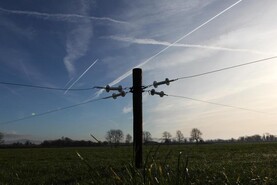Dan Burgar Kuzelicki, policy officer at the Environment, climate change, forestry and bio-economy department of the European Commission, presented the figures at the
Agricultural Science Association’s climate change conference in Portlaoise last week.According to him, the EU’s beef herd size is expected to fall by between 6.6% and 16% across the EU by the time 2030 climate targets are implemented. This is the result of a European Commission model illustrated by the map above.
Dan Burgar Kuzelicki, policy officer at the Environment, climate change, forestry and bio-economy department of the European Commission, presented the figures at the Agricultural Science Association’s climate change conference in Portlaoise last week.
According to him, the EU’s beef herd size is expected to fall by between 6.6% and 16% across the EU by the time 2030 climate targets are implemented. This is the result of a European Commission model illustrated by the map above.
In Ireland, the cost of implementing greenhouse gas emission cuts on beef farms would result in a drop in cattle numbers by up to 5% in the southern half of the country and up to 8% in the northern half.
However, targeting CAP subsidies to cover 80% of the costs associated with better climate efficiency in beef farming would mitigate the impact, with herd size expected to drop by up to 2% in the south and up to 5% in the north under this scenario.
In all cases, beef production is expected to drop.
Additives and grass quality to cut emissions from livestock
Tommy Boland, associate professor of ruminant nutrition at UCD, presented some of the latest research into techniques exploerd to reduce greenhouse gas emissions from cattle and sheep.
A number of inhibitors are being tested as additives to feed to reduce methane production. While some have shown detrimental side effects, a chemical called 3-nitrooxypropanol (3-NOP) is showing promising results. Feeding 2G/day of 3NOP to beef cattle has shown to reduce methane emissions from over 20g/kg to under 10g/kg of weight gain. Meanwhile, methane emissions from dairy cattle receiving 3-NOP have dropped from 18g/kg to 12g/kg of milk solids.
Feeding soya oil and, to a greater extent, linseed oil was also found to reduce the rate of methane emissions from dairy cows, Boland said.
However, he questioned the sustainability of those oil sources and pointed out that grass was an alternative source of fatty acids, with further research required in this area. Boland’s own research shows that improving grass quality has a direct impact on the methane emissions of dairy cow.
Read more
Full coverage: agriculture and climate change





SHARING OPTIONS: